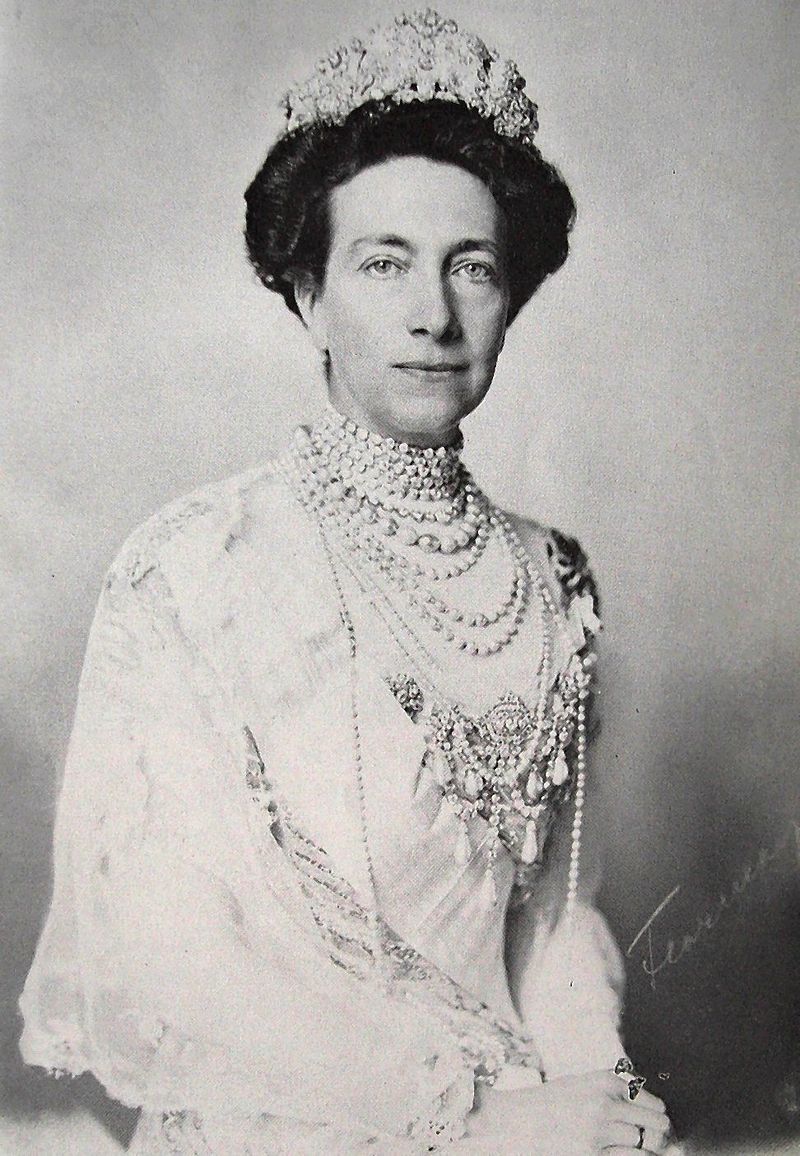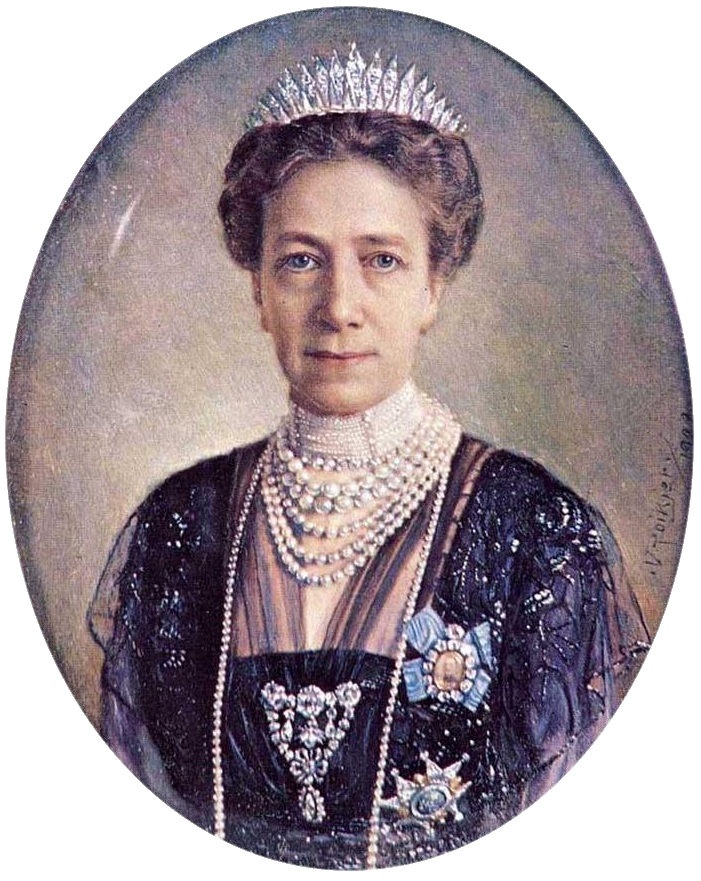by Scott Mehl © Unofficial Royalty 2015

Victoria of Baden, Queen of Sweden. source: Wikipedia
Queen Victoria of Sweden was the wife of King Gustaf V of Sweden. She was born Princess Sophie Marie Viktoria of Baden on August 7, 1862, in Karlsruhe, Grand Duchy of Baden now in Baden-Württemberg, Germany, to Grand Duke Friedrich I of Baden and Princess Louise of Prussia (daughter of Wilhelm I, German Emperor and Princess Augusta of Saxe-Weimar-Eisenach). Through her mother, she was a niece of Friedrich III, German Emperor and his wife, Victoria, Princess Royal of the United Kingdom, and a first cousin of Wilhelm II, German Emperor. She had two siblings:
- Friedrich II, Grand Duke of Baden (1857 – 1928) – married Princess Hilda of Nassau, no surviving issue
- Prince Ludwig Wilhelm of Baden (1865 – 1888) – unmarried
Viktoria was educated privately at home in Karlsruhe and Mainau, learning to speak French and English, studying art and music, and taking a great interest in photography. With their close ties to the German Imperial Family, they often visited the Kaiser’s court. It would later be on one of these visits that Viktoria would meet her future husband.
Viktoria was deeply in love with her first cousin Grand Duke Nicholas Mikhailovich of Russia but Alexander II, Emperor of All Russia would not allow a marriage between cousins. Later, her mother tried to arrange for her to marry the future Wilhelm II, German Emperor, another first cousin. This was also refused because of their close familial tie. However, while in Prussia to attend Wilhelm’s wedding to Augusta Viktoria of Schleswig-Holstein in February 1881, Viktoria met Crown Prince Gustaf of Sweden, the eldest son of King Oscar II of Sweden and Sophia of Nassau. He was quickly taken with Viktoria, and within just a week of their first meeting, he proposed and she accepted. The engagement was announced on March 12, 1881. Over the next several months, Viktoria learned to read and write Swedish and studied Swedish politics and constitutional history.

Victoria and Gustaf, 1881. source: Wikipedia
The couple married in the palace chapel in Karlsruhe, Grand Duchy of Baden now in Baden-Württemberg, Germany, on September 20, 1881. As a great-granddaughter of King Gustaf IV Adolf of Sweden, Victoria’s marriage united the former ruling house of Holstein-Gottorp with the new Bernadotte dynasty, and she was known in Sweden as the ‘Vasa Princess’. She and Gustaf soon settled into their apartments in the Royal Palace of Stockholm which Victoria would retain until her death. The couple had three children:
- King Gustaf VI Adolf (1882-1973) – married (1) Princess Margaret of Connaught, had five children; (2) Lady Louise Mountbatten, had one stillborn daughter
- Prince Wilhelm, Duke of Södermanland (1884-1965) – married Grand Duchess Maria Pavlovna of Russia (divorced), one son
- Prince Erik, Duke of Västmanland (1889-1918) – unmarried
From her youth, Victoria had always suffered from ill health and found the winters in Sweden too harsh to handle. Beginning in 1882, she spent every winter away from her new land, which led to unpopularity with the Swedish people. Victoria and Gustaf’s marriage grew strained due to her frequent absences, and the couple took a trip to Egypt in 1890-1891 to try and fix their relationship. Instead, during their six months in Egypt, Victoria began a relationship with her husband’s aide Baron Gustaf von Blixen-Finecke. Victoria returned to Egypt the following winter without her husband or his aide. Another prominent relationship developed from that first trip to Egypt with Dr. Axel Munthe. Victoria met Munthe while visiting Capri on her way back to Sweden, and the two struck up a fast friendship. He would become her personal physician for the remainder of her life. From several letters between the two, which have been preserved, it appears this was much more than a doctor-patient relationship. What is certain is that Victoria came to depend greatly on Dr. Munthe for her physical and emotional well-being.

Victoria and her husband in Baden-Baden, 1890. source: Wikipedia
Victoria and her family typically spent their summers at Tullgarn Palace which they had taken on in 1881 after their marriage. However, because of the humidity, she found it less-than-pleasant, and her parents offered to finance the building of a new summer residence in an area better suited for Victoria’s health. In 1903, construction began on Solliden Palace on the island of Öland, and Victoria and her family first took up residence in 1906. Personally owned by Victoria, Solliden was later left to King Carl XVI Gustaf of Sweden, who owns it today.
On December 8, 1907, King Oscar II died and Victoria became Queen of Sweden. Although still traveling south during the winters, Queen Victoria took part in all the court festivities and responsibilities of her new role. She traveled extensively with her husband and entertained visiting royalty from around Europe. She spent much time working with several charities, including taking the helm of Sophiahammet after Queen Sofia’s death in 1913. During World War I, Queen Victoria’s German roots often led to unpopularity amongst the Swedes. Despite Sweden’s neutrality, Victoria had a close relationship with Wilhelm II, German Emperor, often visiting the German court during the war. At the end of the war, following the defeat of the German empire, she found that her political ‘power’ in Sweden was gone.
Her remaining years were spent primarily in southern Europe. She lived in Capri for several years before moving to Rome where she purchased a home – Villa Svezia. She made one final trip to Sweden in 1928 for her husband’s 70th birthday celebrations.

Queen Victoria, painted by Victor Roikjer, 1928. source: Wikipedia
In declining health, Queen Victoria of Sweden died of a heart attack on April 4, 1930, at Villa Sveziain Rome, Italy. At her bedside were her husband King Gustaf V, her son Wilhelm, Dr. Munthe, and her devoted maid and companion Agnes Bergman. Her body was returned to Sweden on HMS Drottning Victoria, and a state funeral took place on April 12. She is buried at the Riddarholmen Church in Stockholm, Sweden.
Kingdom of Sweden Resources at Unofficial Royalty
- Kingdom of Sweden Index
- Swedish Orders and Honours
- Swedish Royal Dates
- Swedish Royal Burial Sites
- Swedish Royal Christenings
- Swedish Royal FAQs
- Swedish Royal Residences
- Swedish Royal Weddings
- Line of Succession to the Throne of Sweden
- Profiles of the Swedish Royal Family
This article is the intellectual property of Unofficial Royalty and is NOT TO BE COPIED, EDITED, OR POSTED IN ANY FORM ON ANOTHER WEBSITE under any circumstances. It is permissible to use a link that directs to Unofficial Royalty.
